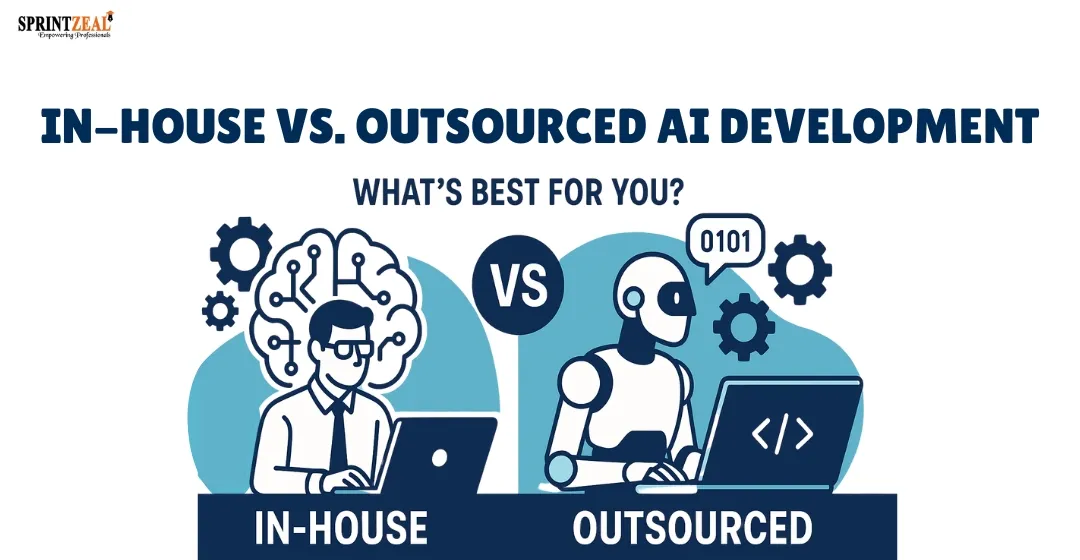In-House vs. Outsourced AI Development: Finding the Right Balance
-
 By Sprintzeal
By Sprintzeal - Published on Jul 24 2025

The market for AI talent has never been higher. Job listings demonstrate "junior" machine learning engineers earning $180K base pay. Before bonuses. Before stock. Before firms add other benefits to keep talent from leaping to OpenAI.
And yet, it's not succeeding. Firms continue to lose AI talent at a rate they cannot replace.
This leaves companies in a no-win situation. Do they spend cash and two years trying to develop an internal team? Or should they be strategic about obtaining the talent they require?
Table of Contents
- Why Building Internal Teams Is Financial Suicide Right Now
- The Skills Problem Is Even Worse
- Smart Companies Are Going External
- When External Teams Make Perfect Sense
- The Hybrid Sweet Spot
- This offers firms a number of gigantic benefits:
- What Companies Really Do Need Internally
- Finding the Right External Partner
- Making Partnerships Actually Work
- How to Select the Proper Method
- Why the Talent Shortage Likes External Partnerships
- The Actual Economics
- Keeping Up with the Technology Times
- The Next Move
Why Building Internal Teams Is Financial Suicide Right Now
Arithmetic hurts. That "junior" ML engineer who costs $180K? Add payroll tax, benefits, hardware, and training. Companies are really paying $220K for someone who may leave in six months.
Need a data scientist as well? Add another $160K. Project manager that won't blow things off course? $150K minimum, and they're scarcer than unicorns.
Three individuals, half a million bucks, zero promises they'll stay around or create anything worthwhile.
But the cash isn't even the worst of it. Getting these individuals is like winning the lottery in reverse.
One fintech CEO recently spent eight months searching for a single AI engineer. Made four offers. First three candidates accepted better offers elsewhere. The fourth candidate accepted, worked precisely six weeks, then departed for Google with a 40% increase.
Meanwhile, their leading competitor rolled out AI-driven fraud detection and began poaching customers left and right.
The Skills Problem Is Even Worse
Let's say a company somehow succeeds in hiring someone. There's a high likelihood they can't deliver what's required.
The majority of AI engineers have an academic or Google/Facebook background. The academics are familiar with all research papers written since 2015 but have never worked with dirty real-world data. Veterans from big tech assume infinite computing resources and legion-sized data engineers.
Most startups don't have either.
Perfect illustration: A medical company recruited a Stanford PhD in machine learning. Great scientist, sterling CV. Half a year later they had terrific deep learning models that collapsed entirely when presented with real patient data from real hospitals.
Why? Because this specialist had only dealt with immaculate cleaned-up research datasets. Real medical data is dirty, incomplete, and contains strange edge cases that destroy textbook algorithms.
Each industry has its own idiosyncrasies. Healthcare requires HIPAA expertise. Manufacturing involves knowledge of industrial processes. Finance calls for experience in fraud detection. Good luck locating someone technically brilliant AND knowledgeable about particular business issues.
Smart Companies Are Going External
What's changing minds about outsourcing: dealing with an appropriate AI development company fixes most of these headaches in an instant.
Good external teams are not just random groups of freelancers. They are groups of individuals who have been working together for years. The data scientist understands how the ML engineer's brain works. The project manager knows what's real and what's fantasy. They've established systems for working together.
Most importantly, they possess experience businesses simply cannot employ. Computer vision engineers who've tuned factory inspection systems. NLP engineers who've created medical document analysis software. Recommendation engine designers who've managed millions of users.
These are not theoretical experts. These are individuals who've developed actual solutions and made actual mistakes. They know what actually works and what sounds great but blows months of development time.
Case in point: A logistics firm required AI to optimize routes. Zero in-house ML competence. Rather than taking 18 months to assemble a team, they sourced an outside partner. Four months later, the solution was deployed and shaving $300K per year off fuel expenses. The project had paid for itself after the first quarter.
When External Teams Make Perfect Sense
Certain situations essentially shout for outsourcing:
Testing Concepts Without Obligation Need to establish that AI can fix something before committing to full-time staff? External teams allow companies to test ideas quickly. If it works, wonderful. If not, there are no hired guns that can't be employed.
Specialized Technical Needs Computer vision for quality assurance? Natural language processing for contracts? These are one-off skills, not full-time positions for most organizations.
Deadline Pressure External teams begin next week. Internal hiring is months. Occasionally speed trumps all else.
Clear Project Boundaries Defined scope with precise deliverables? External teams frequently produce better outcomes sooner than creating capabilities that will infrequently be utilized.
The Hybrid Sweet Spot
Smartest firms have learned: maintain a small internal staff for strategy and direction, yet ally with external experts for development muscle and technical proficiency.
Internal personnel manage requirements, make strategic choices, and own systems over the long term. External partners provide development firepower and deep skill for given projects.
This offers firms a number of gigantic benefits:
Flexible Capacity: Need a big project? Scale up external resources. Project finished? Scale down. No permanent staff, no inactive costly talent in slow times.
Knowledge Remains Internal Internal team members remain engaged during development, so firms aren't at a loss when outside partners complete their efforts. And internal teams benefit from experienced developers.
Cost Control Pay for expert skills only when necessary, not on a full-time basis. Works well for computer vision or high-level NLP that isn't constantly required.
Risk Management Having multiple sources of capability means firms aren't ruined if one resource is experiencing issues.
Access to Innovation External partners serve several clients from various industries. They introduce new ideas internal teams wouldn't consider.
A manufacturing organization does this to perfection. Two veteran AI engineers internal for strategy and upkeep. Three various external partners for niche work - computer vision with one company, predictive analytics with another, overall development with a third.
End result: they essentially have 15+ AI experts at their disposal without having to hire them all.
What Companies Really Do Need Internally
No matter how good external partners are, companies do require a bit of internal AI brawn. Otherwise they can't analyze work or make decent decisions.
Minimum team requirements:
AI Product Manager A person who speaks business needs and technical reality. They communicate with internal and external development teams to ensure that projects really do address business issues.
Technical Lead Engineer familiar enough with AI to analyze architectures and check code. Not necessarily a research scientist, but just fundamentally sound.
Data Engineering AI is only as good as the data. Need internal staff operating data pipelines, access controls, and quality problems.
This internal core team should be able to co-operate with external partners while incrementally developing more internal expertise.
Finding the Right External Partner
Not every AI development business is an investment worth making. Here's what really counts:
Industry Experience Healthcare AI is nothing like retail AI. Making stuff has nothing to do with finance. Get individuals who've tackled related issues in the past.
Stable Teams' high turnover is a warning sign. Seek veteran individuals who've worked together as a unit, not businesses that swap junior developers between assignments.
Communication Skills Technical brilliance is useless if they can't explain what they're doing. Good partners ask smart questions about business and constraints.
Proven Process Look for structured approaches with regular check-ins and clear milestones. Avoid anyone who wants to disappear for months then show up with a finished system.
Ongoing Support AI systems need continuous care. Make sure they'll stick around after launch, not dump everything and run.
Making Partnerships Actually Work
Good outsourcing requires active management:
Detailed Requirements Up Front External teams require far more context than internal folks. Take time to describe business, users, and constraints in detail.
Regular Check-ins Weekly reviews avoid nasty surprises. Don't wait until the end to realize they've built the wrong thing.
Knowledge Transfer Planning: Make this a part of the project from day one. Internal folks need to know the system architecture and key decisions.
Performance Monitoring Establish tracking and measurement prior to launch. Benefits in development and upkeep over the long term.
How to Select the Proper Method
Internal vs external vs blend based on particular circumstances:
- Strategic Significance
Key competitive competency likely must be held internally. Support functions are okay externally.
- Timeline Urgency
External collaborators begin sooner but in-house groups gain speed over time for steady work.
- Budget Reality
Internal teams require continuous investment for years. External partnerships provide flexible costs associated with individual projects.
- Control Requirements
Require close control and thorough customization? Internal development. Clear requirements with proven methods? External is wonderful.
Why the Talent Shortage Likes External Partnerships
This AI talent shortage isn't disappearing. Although universities can't churn out qualified individuals quickly enough, and each company wants the same talent.
Smart business leaders work with AI development companies like 8allocate for flexible resourcing when internal teams hit capacity or need specialized expertise for new projects.
Businesses are not simply outsource-developing - they are purchasing access to skills that would take years to develop in-house.
The Actual Economics
Internal vs external costs are compared:
Internal Costs:
- Compensation and benefits ($150K-220K+ total per individual)
- Hiring costs (frequently 20-30% of initial-year pay)
- Training and hardware
- Management burden
External Costs:
- Project fees (dependent on scope and complexity)
- Coordination and management time
- Investment in knowledge transfer
Break-even usually occurs at the 12-18 month mark. But this ignores vital considerations such as speed to market, access to special skills, and ability to scale up or down.
For time-critical projects or specialist requirements, external collaborations usually achieve much better ROI.
Keeping Up with the Technology Times
AI is changing rapidly. New tools and methods emerge regularly. Methods must keep up with the technology.
Internal teams get updated with training and conferences. External partners must provide leading-edge knowledge from working on multiple industries and clients.
Hybrid strategies provide firms with both - internal continuity and external innovation. Core teams retain institutional know-how while partners add new methods and technologies.
Firms succeeding with AI get a sense of when to retain AI development internally versus outsource to specialists. They develop adaptable strategies that balance cost, speed, and strategic control.
The Next Move
There is no magic rule to apply here. The correct course of action will vary with situation, resource, and objective.
Begin by objectively assessing existing capability and how long in reality it will take to develop expertise internally. Include the actual cost of attracting and retaining the best AI talent in today's difficult environment.
Consider project pipelines as well. Ongoing AI development efforts could warrant internal spend. Complex projects or immediate capability requirements tend to be more effective with external partners.
Successful companies usually end up with hybrid models. They begin with external partners to validate concepts and achieve quick wins, and then build up internal capabilities over time for longer-term sustainability.
The secret is keeping the focus on business outcomes, rather than technology for the sake of it. AI development must address actual problems and deliver competitive opportunities, rather than simply showcase technical prowess.
Ready to avoid the recruitment headaches and begin delivering AI outcomes? Work with seasoned AI development professionals who can get projects underway while businesses work out their future strategy.
Subscribe to our Newsletters
Popular Programs
ISO/IEC 38500 IT Corporate Governance Manager
Live Virtual Training
- 4.3 (650 + Ratings)
- 36k + Learners
ISO/IEC 38500 Lead IT Corporate Governance Manager
Live Virtual Training
- 4.8 (650 + Ratings)
- 10k + Learners
Trending Posts
The Reason For The Fall Of BlackBerry
Last updated on Nov 29 2024
Understanding ISO 37101 Foundation and Its Role in Sustainable Development
Last updated on Sep 24 2024
Mastering the Art of Interpersonal Communication
Last updated on Oct 31 2025
Benefits of ISO 26000 for Strengthening Business Continuity
Last updated on Aug 8 2024
Business Analysis Certifications 2024
Last updated on Jun 12 2024
How to Become a Business Analyst: Step-by-Step Guide
Last updated on Oct 26 2023
Categories
- Other 62
- Agile Management 57
- Cloud Computing 50
- Project Management 170
- Big Data 58
- Business Management 79
- Digital Marketing 73
- IT Service Management 29
- Programming Language 47
- AI and Machine Learning 67
- IT Security 108
- Quality Management 77
- IT Hardware and Networking 25
- Microsoft Program 4
- Workplace Skill Building 11
- Risk Management 9
- Information Security 8
- Leadership and Management 7
- Corporate Training and Development 1
Trending Now
Process Maps - How to Create and Use Them
ebook11 Best Business Blogs 2024 (UPDATED)
ebookCBAP Certification Exam Preparation Guide 2024
ebookBusiness analyst career path in 2024
ebookCCBA Certification Career Transformation Guide
ebookUpdated Business Analyst Interview Questions and Answers 2024
ebookTop Salesforce Interview Questions and Answers 2024
ebookWhat Is Business Continuity Planning?
ebookBusiness Analysis Certifications 2024
ebookBusiness Process Mapping Guide for Beginners
ebookBusiness Analyst Skills List 2024
ebookWhat is Business Analysis - A Complete Guide
ebookRemote Working Methods for 2024
ebookBest Business Analytics Tools in 2024
ebookWhat is Salesforce? A Beginner's Guide
ebookWhat is Digital Business? An Introduction
ebookBusiness Analyst Job Requirements - Qualifications and Skills
ebookBusiness Analyst Job Profile – Role, Skills and Challenges
ebookTypes of Business Analyst Roles in 2024 – Responsibilities and Earnings
ebookBusiness Analyst Qualifications and Skills in 2024
ebookBusiness Analyst Career Road Map Explained
ebookHow to Become a Business Analyst: Step-by-Step Guide
ArticleBusiness Analyst Job Description - Key Role and Responsibilities
ebookBusiness Analyst Career Guide 2023
ebookWhy Become a Business Analyst in 2023: Top Reasons and Scope
ArticleFundamentals of Business Impact Analysis (BIA): Best Practices to Implement
ArticleBenefits of ISO 26000 for Strengthening Business Continuity
ebookThe Essential Guide to ISO Standards in Business Management
ArticlePrinciples of ISO 14001 Foundation
ArticleUnderstanding ISO/IEC 38500 IT Foundation and its application
ArticleTop Professional Business Certifications Trending in 2025
ArticleSteps to Implementing ISO 22301 Foundation: A Complete Guide
ebookUnderstanding ISO 37101 Foundation and Its Role in Sustainable Development
Article7 Core Principles of ISO 26000: A Guide to Ethical Organizational Practices
ebookThe Reason For The Fall Of BlackBerry
ArticleGoogle and Innovation: What Makes it Most Innovative?
ArticleBest Business Analysis Books You Need to Read in 2025
ArticleWhat is MBA in HR: Overview, Scope and Benefits
ArticleHow to Become a Product Manager: A Step-by-Step Guide
ArticleWhy Reliance Industries is a Global Giant?
ArticleTata Growth and Global Success: Best Lessons and Their Impact
ArticleMost Sold Ford Car: Global Rankings and Success Insights
ArticleHow Disney's Success Story Became a Global Entertainment Powerhouse?
Article4 Proven Approches to Build a Strong LinkedIn Community
ArticleEssential Business Tools Every Female Founder Should Have
ArticleThe Role of Technology in Scaling a Small Business
ArticleMastering Student Finances with AI: The Ultimate Guide for Comfortable Living
ArticleBusiness Automation: Reshaping Modern Enterprises
ArticleThe ROI of Automated Invoice Processing: What Can Your Company Save?
ArticleCareer Opportunities After a Distance MBA in India
ArticleModeling Business Processes in Law Firms: Optimization Through Modern Technologies
ArticleBoosting E-Learning Visibility with SEO and Video Translation Strategies
ArticleBuild a Store That Sells: E-commerce Essentials Explained
ArticleMaximizing E-Commerce Efficiency: Top Plugins Every Online Store Needs
ArticleMastering Digital Communication: Tools That Redefine Transparency in Teams
ArticleWhat Is HubSpot CRM & Why Should You Choose It For Your Business?
ArticleHow Does Personalization Impact Cold Email Success?
ArticleThe 5 Best Lead Finder Tools for Brand Collaborations
ArticleThe Complete Guide to Bootstrapping Your SaaS
ArticleHow to Build a One-Person Business Like a Team of Ten? Bloggervoice
ArticleMaximize ROI: Why Quality Video Animation Services Matter
Article6 Digital Tools Every Solo Founder Should Be Using by Now
ArticleHandle Sales, Tax, and Inventory Seamlessly with Billing Software for PC
ArticleTax Saving Options for Working Individuals in 2025
ArticleHow to Use AI Video Generators and Online Video Translators to Grow an International Audience
ArticleBest Accounting Software For Etsy Bookkeeping
ArticleOutsourcing: Everything You Need to Know
ArticleAffordable Asset Management Software for Small Teams
ArticleFrom Delays to Instant Approvals: The Power of Real-Time Insurance in Labs
Article3 Best Video Meeting Tools to Simplify Remote Work and Hybrid Teams
Article5 Top Accounting Software Options for Construction Firms
Article5 Best Debt Collection Tools for Faster Payments and Scalable Growth
ArticleWhy Manufacturers Should Invest in Both Machines and People
ArticleMBA Interview Questions and Answers Guide 2025
ArticleTop 7 Tools for WhatsApp And HubSpot Integration in 2025
ArticleThe Future of Networking and CRM: Building Stronger Business Connections
ArticleThe Best 3D Architectural Rendering Companies
ArticleMastering the Art of Interpersonal Communication
Article






+Foundation.webp)










